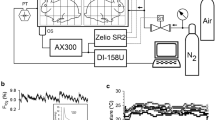Abstract
Two experiments were conducted to ascertain the cardiovascular accompaniments of differential Pavlovian jaw movement (JM) conditioning. The first examined the blood pressure (BP) changes that accompany the tachycardiac conditioned responses (CRs) associated with JM conditioning. The BP response in all instances consisted of a depressor response that was greater to the reinforced CS+ than CS-, although the magnitude of the CR was quite small. The second experiment determined the effects of peripheral autonomic antagonists on the cardiac accelerations associated with JM conditioning. It was found that the peripheral vagal antagonist methyl scopolamine completely abolished responses to both CS+ and CS-, whereas atenolol, a beta adrenergic antagonist, augmented the response, compared to saline control injections. The JM responses were also affected by the autonomic blockades, with minimal responding occurring in the scopolamine group but slightly more JM CRs in the atenolol group, compared to saline control animals. These results suggest that the major cardiovascular response to an appetitive stimulus, which evokes JM conditioning, consists of cardiac accelerations with the BP depressor responses playing a minimal, if any, role. Moreover, these conditioned cardiac increases appear to be due solely to the release of vagal inhibition.
Similar content being viewed by others
References
Albiniak, B. A. & D. A. Powell. (1980). Peripheral autonomic mechanisms and Pavlovian conditioning in the rabbit (Oryctolagus Cuniculus).Journal of Comparative and Physiological Psychology, 94: 1101–1113.
Berry, S. D., M. A. Seager, Y. Asaka & R. L. Borgnis (2000). Motivational issues in aversive and appetitive conditioning paradigms. J. E. Steinmetz & D. S. Woodruff-Pak (eds.),Eyeblink Classical Conditioning Volume 2: Animal Models (pp. 287–312). Boston, MA: Kluwer Academic Publishers.
Buchanan, S. L. & D. A. Powell (1982). Cingulate cortex: Its role in Pavlovian conditioning.Journal of Comparative and Physiological Psychology, 96: 755–774.
Gibbs, C. M. (1992). Divergent effect of deep cerebellar lesions on two different conditioned somatomotor responses in rabbits.Brain Research, 585: 395–399.
Gormezano, I. (1972). Investigations of defense and reward conditioning in the rabbit. In A. H. Black and W. F. Prokasy (eds.),Classical Conditioning II: Current Research and Theory. New York, NY: Appleton-Century-Crofts.
—, E. J. Kehoe & B. S. Marshall (1983). Twenty years of classical conditioning research with the rabbit.Progress in Psychobiology and Physiological Psychology. 10: 197–275.
Graham, F. K. & R. K. Clifton. (1966). Heart-rate change as a component of the orienting response.Psychological Bulletin, 65: 305–320.
Gray, J. A. (1982).The Neuropsychology of Anxiety: An Inquiry into the Functions of the Septo-hippocampal System. New York: Oxford University Press.
Joseph, J. A. & D. A. Powell (1980). Peripheral 6-hydroxydopamine administration in the rabbit (oryctolagus cuniculus): Effects on Pavlovian conditioning.Journal of Comparative and Physiological Psychology, 94: 1114–1125.
Kapp, B. S., P. J. Whalen, W. F. Supple & J. P. Pascoe (1992). Amygdaloid contributions to conditioned arousal and sensory information processing. In J. P. Aggleton (ed.),The Amygdala: Neurobiological Aspects of Emotion, Memory, and Mental Dysfunction (pp. 229–254), New York, NY: Wiley-Liss, Inc.
Kazis, E., W. L. Milligan & D. A. Powell (1973). Autonomic-somatic relationships: blockde of heart of heart rate and corneoretinal potential.Journal of Comparative Physiological Psychology 84: 98–110.
Lacey, J. I. (1956). The evaluation of autonomic responses: toward a general solution.Annals of New York Academy of Science, 67: 125–163.
LeDoux, J. E. (1996).The Emotional Brain. New York, NY: Simon & Schuster.
McLaughlin, J. & D. A. Powell. (1999). Pavlovian heart rate and jaw movement conditioning in the rabbit: effects of medial prefrontal lesions.Neurobiology of Learning and Memory, 71: 150–166.
—, D. A. Powell & J. D. White (2001). Characterization of the neuronal changes in the medial prefrontal cortex during jaw movement and eyeblink Pavlovian conditioning in the rabbit.Behavioural Brain Research, 132: 117–133.
McLaughlin, J. & D. A. Powell. (2002). Post-training prefrontal lesions impair jaw movement conditioning performance, but have no effect on accompanying heart rate changes.Neurobiology of Learning and Memory, In Press.
Oliver, C. G., R. A. Swain & S. D. Berry (1993). Hippocampal plasticity during jaw movement conditioning in the rabbit.Brain Research, 608: 150–154.
Powell, D. A. (1979). Peripheral and central muscarinic cholinergic blockade: Effects on Pavlovian conditioning.Bulletin of Psychonomic Society, 14: 161–164.
—, C. M. Gibbs, B. Maxwell & D. Levine-Bryce (1993). On the generality of conditioned bradycardia in rabbits: assessment of CS and US modality.Animal Learning and Behavior, 21: 303–313.
— & E. Kazis (1976). Blood pressure and heart rate changes accompanying classical eyeblink conditioning in the rabbit (Oryctolagus cuniculus).Psychophysiology, 13: 441–447.
— & D. Levine-Bryce (1988). A comparison of two model systems of associative learning: heart rate and eyeblink conditioning in the rabbit.Psychophysiology, 25: 672–682.
—, K. Watson & B. Maxwell. (1994). Involvement of subdivisions of the medial prefrontal cortex in learned cardiac adjustments.Behavioral Neuroscience, 108: 294–307.
Smith, M. C., V. DiLollo & I. Gormezano (1966). Conditioned jaw movement in the rabbit.Journal of Comparative and Physiological Psychology, 62: 479–483.
Wenzel, B. M. (1961). Changes in heart rate associated with responses based on positive and negative reinforcement.Journal of Comparative and Physiological Psychology, 54:638–644.
Author information
Authors and Affiliations
Corresponding author
Rights and permissions
About this article
Cite this article
Powell, D.A., McLaughlin, J., Churchwell, J. et al. Heart rate changes accompanying jaw movement Pavlovian conditioning in rabbits: Concomitant blood pressure adjustments and effects of peripheral autonomic blockade. Integrative Physiological & Behavioral Science 37, 215–227 (2002). https://doi.org/10.1007/BF02734182
Issue Date:
DOI: https://doi.org/10.1007/BF02734182




